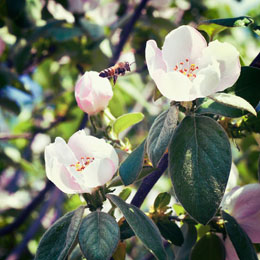The flowering quince is one of the most gorgeous plants that can adorn your garden. Just read below for some information on this beautiful plant.

She's spiny when she's young. With proper care, she'll grow drop-dead gorgeous. In addition to her stunning beauty, she'll mesmerize you by emanating a delightful fragrance that you'll love! Dreamy?? Yes, the flowering quince can have that effect on people. (Gotcha!) Given in this article, is all you'll ever want to know about it, and then some more!
The Basics
- The scientific name of the flowering quince is Chaenomeles speciosa.
- The name 'flowering quince' has replaced 'Japonica' which is what gardening enthusiasts used to call it.
- This plant is native to East Asia, more specifically to Japan, Korea, and China.
- It is a deciduous flowering plant which is mostly used as an ornamental shrub which blossoms fully in spring.
- It bears red or pink flowers.
- The fruit of this plant resembles a small apple which is edible by man as well as small animals and can be used to make jellies.
- This plant has deep green foliage which has a shiny appearance. The leaves are green when planted and young, but by fall, they gradually turn into a shimmering yellow and eventually become red just before they shed.
- Initially, the stem is gray, thorny, and spiny. It then turns deep brown as the plant grows further.
- The average height that it grows to is somewhere between 6-10 feet.
- Some of its varieties include: Cameo, which has a clean foliage and is more resistant to diseases than the others, Jet Trail, which is a short variety that bears white flowers, and Nivalis, which grows upright and has white blossoms, mostly in April.
- It is a great plant for landscaping.
- It can also be used as a hedge plant.
Requirements
- Soil: The flowering quince can grow well in different types of soil, except really wet soil or in soil with a high pH level.
- Sun: Make sure that you plant it in a spot that receives full sunlight. It does not really appreciate a shady spot too much.
- Water: It is important that you keep the soil well-watered, especially during the initial phase of planting it. But keep the soil drained. Don't over-water the plant as this might not work very well for it.
- Fertilizer: Fertilizing the plant by the end of summer is a good idea.
Steps to Plant It- Choose the site where you're going to plant the sapling and make sure it receives full sunlight.
- Get a sapling from your nursery.
- Loosen the soil on the site, fertilize it, and dig a hole (depth: equal to root ball, width: more than root ball).
- Remove the sapling from its container and slowly lower it into the hole.
- Fill the hole with the surrounding soil and gently press with your fingers and water the area.
- You can mulch the area surrounding the plant to enhance the growth and health of the plant.
- Pruning the plant is not really required quite often, but you can prune it when you feel the plant is looking too unruly because of its thorny and spiny appearance.
These were the easy directions for planting this wonderful plant. Many flower gardens use a flowering quince to enhance their beauty. The plant looks glorious in spring, laden with the pretty blossoms which have a divine fragrance. So get yours right away and enjoy your spring evenings in the company of this stunning plant!






 She's spiny when she's young. With proper care, she'll grow drop-dead gorgeous. In addition to her stunning beauty, she'll mesmerize you by emanating a delightful fragrance that you'll love! Dreamy?? Yes, the flowering quince can have that effect on people. (Gotcha!) Given in this article, is all you'll ever want to know about it, and then some more!
She's spiny when she's young. With proper care, she'll grow drop-dead gorgeous. In addition to her stunning beauty, she'll mesmerize you by emanating a delightful fragrance that you'll love! Dreamy?? Yes, the flowering quince can have that effect on people. (Gotcha!) Given in this article, is all you'll ever want to know about it, and then some more!